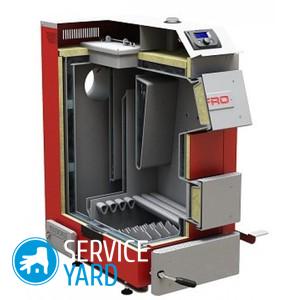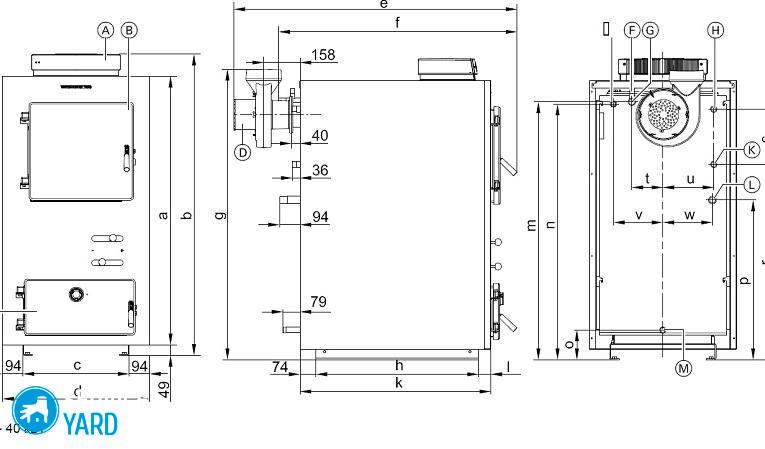DIY heating boiler - drawings

In addition to buying heating equipment, presented on the market by domestic or international manufacturers, there is always the opportunity to make a heating boiler with your own hands, the drawings of which can be freely found on the network. At the same time, you can save on a whole list of options without which your heating system can well do. All that is needed is knowledge of the device and the principle of operation of the selected type of boiler, materials, tools and practical skills with them.
to contents ↑The main types of heating boilers
If desired, you can make almost any type of heating boiler. The main thing here is to choose the right one, and for this you need to know the main advantages and disadvantages of the most common types of heating equipment. So, heating boilers are:
- Gas. It is extremely undesirable to engage in the manufacture of this type of boilers on their own - such technical requirements are presented to gas equipment that you are unlikely to be able to fulfill in artisanal conditions.
- Electric. The relatively high popularity of boilers in this category is explained by the simple design and relatively low requirements regarding safety during operation and installation.
Important! The main disadvantage of electric boilers is the high price of electricity. As a result of this, such equipment is usually used to provide periodic heating, for example, a garage or a summer residence.
- Fuel oil. The design of such boilers is not very complex. However, the subtleties and cost of the nozzles that supply fuel to the combustion chamber will make anyone think carefully before proceeding with the manufacture of a heating device running on diesel or fuel oil.
- Solid fuel. Representatives of this type of heating equipment are optimally suited both for private homes and for various objects of the industrial or commercial sector. Universality in application and high efficiency provide such boilers with the highest demand in the market.
to contents ↑Important! According to the principle of action, solid fuel boilers are divided into pyrolysis, wood, pellet and long burning. Boilers of long burning are the most popular for making by themselves, while pellet and pyrolysis boilers are used much less often due to the high cost of individual elements.
What determines the design?
On what exactly will be the design of the heating boiler, some conditions may affect:
- Type of fuel.
- Availability and cost of materials.
- The method of circulation of the coolant.
Materials for assembly:
- The highest durability is shown by stainless heat-resistant steel. However, just it has the highest cost, and its processing is a rather difficult task, which cannot be handled without special equipment. The same can be said about cast iron, which, however, is much cheaper than stainless steel.
Important! Traditionally, for the manufacture of heating boilers, sheet steel with a thickness of 4 mm or more is used - this option is relatively easy to process and, most importantly, it is durable and quite reliable.
- To ensure the natural circulation of the coolant, it is required to use heating circuits and large-sized connecting fittings, and the storage tank should be placed at a height. When this is not possible, you will have to use a circulation pump - it will make it possible to reduce the diameter of the pipes. However, the pumping system of the heating boiler is volatile, which should be considered when choosing the design of the device, as well as its functionality.
to contents ↑Important! The nozzles that your boiler will be equipped with must have a diameter of at least 32 mm - a thick-walled steel pipe can be used for manufacturing. The heating circuit must be made of galvanized steel, not forgetting the sealing of threaded joints.
Features of the design of solid fuel boilers
The cheapest option in order to make a heating boiler with your own hands is a wood burning boiler. Structurally, such a device is two containers that are placed one on top of the other. The inner one plays the role of a furnace, and the outer one functions as a heating tank.
Important! The design of the wood boiler is quite simple, and it can work not only with wood, but also with some other types of solid fuel.
The design of a wood boiler includes the following:
- Steel firebox (with door).
- Grids of the furnace.
- Ashpit (with a door).
- Chimney.
- Soot collector.
- Inlet and outlet nozzles.
- Gate valve.
- Cast iron cover.
- Legs.
to contents ↑Important! The main disadvantage of a wooden boiler is low efficiency, that is, too much fuel consumption or a constant lack of heat in the house.
Design features of pyrolysis boilers
Pyrolysis boilers are more expensive to manufacture, they have two combustion chambers - for pyrolysis gas and for fuel, and some of their elements themselves are not cheap. Nevertheless, this equipment is in considerable demand due to its economy - it pays off completely in just 3-4 seasons.
The classic pyrolysis scheme of a boiler includes the following:
- Combustion chamber with nozzle.
- Gasification chamber.
- Chimney system.
- Air supply system.
- Water heat exchanger.
- Loading chamber.
- Pressure and temperature sensors.
- Coolant circulation system.
- Control valve
Design features of pellet boilers
Pellet boilers were invented at the end of the 20th century. They operate on pressed sawdust, and their main principle of action is to transfer heat from the gas released from the combustion of the latter, which heats the coolant in the heat exchanger.
The design of the pellet boiler includes the following:
- Body.
- Heat exchanger with water circuit.
- A combustion chamber with an air window and a cleaning door.
- Thermal insulation gasket.
- Smoke exhauster.
- Automation of management and control.
to contents ↑Important! In pellet-type boilers, cast iron heat exchangers are best used: they have a higher rate of heat transfer and are not susceptible to corrosion.
Making an electric boiler
Making a heating boiler with your own hands is a responsible task. The main element of an electric heating device is a thermoelectric heater (TEN), which is necessary to convert electricity to heat.
Important! The case of such an assembly can be made of any material, and the nodes that are needed for its operation - sensors, regulators, can be purchased at any specialized store.
The design of the electric boiler consists of the following elements:
- Expansion tank.
- TEN.
- Safety valve.
- Circulation pump.
- Filtration unit.
The coolant in the system is able to circulate as a natural way, for which it is necessary to provide for a height difference between the tank and the radiators of the boiler, or forced, using a pump. The easiest option for an electric boiler is to install a heater in a heating system. If this design does not fit, then you can make an electric boiler with a removable nozzle - this will allow you to quickly get to the heater if you need to replace or repair.
The most optimal solution for heating, for example, a small cottage is a separately located small electric boiler. The pipe of such an aggregate will have a diameter of about 220 mm, and the body length will be no more than half a meter, which makes it possible to install it almost anywhere (of course, taking into account safety rules).
to contents ↑Important! The body of the electric boiler must be tight. It is equipped with an opening for the entry of a heated coolant into the heating system and a pipe for supplying already cooled water back.
Alternatives for DIY
In addition to electric and solid fuel boilers, a number of other alternative heating devices are also suitable for self-production, for example:
- Induction - are transformers that consist of a primary and secondary winding. In a boiler of this type of electric power, the external winding is converted into eddy current, and the generated magnetic field is transferred to the internal one, which transfers energy to the coolant.
- Condensation - they store the thermal energy of the condensate, due to which they are considered more efficient than solid fuel and gas. The condensation of steam in the heat exchanger occurs with a special design that provides such boilers with an approximately 20% efficiency advantage over traditional gas equipment.
- Liquid fuel - evaporate mining, and then burn its vapor. The energy thus obtained is sent to a heat exchanger, which heats the heat agent of the heating system. Such equipment has two significant drawbacks: a large number of emissions in the atmosphere and low efficiency.
- Combined - universal in application equipment. But for its independent construction will require skill, as well as excellent knowledge of the principles of operation of various types of heating equipment. Individual elements of such devices can be quite expensive, but in general, combined types of boilers can pay off in just 5-6 seasons.
to contents ↑Important! In the manufacture of a heating unit of any type, it is necessary to be guided by all the requirements of safety rules and current standards in relation to the category of equipment you have chosen.
Stock footage







As you can see, to make a heating boiler with your own hands, you need to take into account many nuances. If you doubt your abilities, then it is better to think about entrusting this work to a specialist, since such equipment should be manufactured in accordance with all safety standards and rules.
- How to choose a vacuum cleaner taking into account the characteristics of the house and coatings?
- What to look for when choosing a water delivery
- How to quickly create comfort at home - tips for housewives
- How to choose the perfect TV - useful tips
- What to look for when choosing blinds
- What should be running shoes?
- What useful things can you buy in a hardware store
- Iphone 11 pro max review
- Than iPhone is better than Android smartphones



Report typo
Text to be sent to our editors: